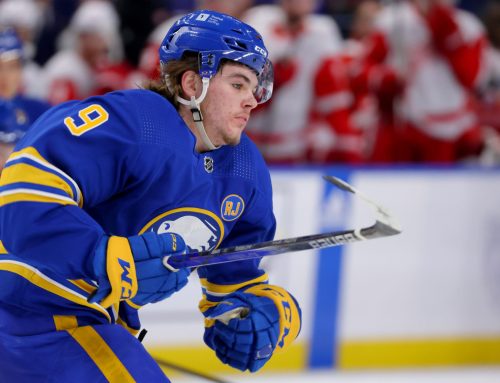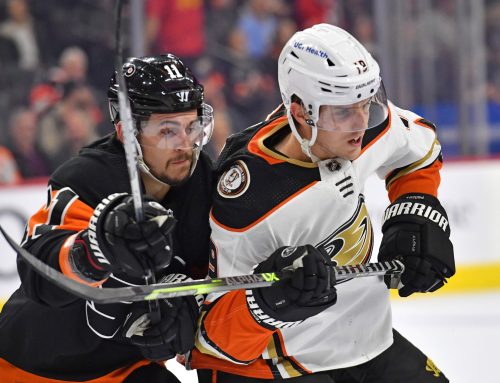
Get your brooms out Bruins’ fans, because the sweep has been completed.
By now, most of you have heard the whispers of a magical sweep curse that has been transmitted via the handshake at the end of several series. The Penguins gave it to the Islanders, who passed it on to the Hurricanes. One can only deduce that now Boston is ripe for a sweepin’ in the Cup final.
Tuukka Rask was good again on Thursday evening – even though he didn’t really need to be for long stretches of the contest. He slammed the door shut, making 23 saves and improving his playoff save percentage to a healthy 0.942 in 17 games.
There are three things you need to go on a deep run:
- A hot goaltender
- Your big boys showing up
- Depth scoring
The Bruins have received all three thus far. Now we hope for a lengthy Western Final to make up for the lack of hockey every second night for the next week.
Oddly enough, Sebastian Aho and Teuvo Teravainen were split up and not reunited despite the Canes failing to produce any consistent pressure. Despite the conclusion, this has been a spectacular campaign by the Bunch of Jerks. Great things are coming for them in the near future. Especially if they can receive high-end goaltending as they did for parts of this year.
**
Start getting excited about the Fantasy Prospect Report. This puppy is going to be the best one yet. Pre-order it here
**
I have this theory that depending on how you view a player (or the metrics that you value) will determine if an asset is underrated or due for a regression. My target to explore today is Tomas Hertl.
The 25-year-old obliterated his previous career-highs in goals (35), assists (39), points (74), powerplay goals (11), powerplay points (15), conversion rate (19.9%), TOI (19:01) and PPTOI (2:52). He accomplished these feats while shooting the puck a little less than normal.
So, do we have ourselves a new mainstay in the 70-plus point club, or is he due to regress to the mean?
First off, the positives. As mentioned, the Czech forward played exceptionally well in 2018-19 (and continues to do so in the post-season). His most common linemates were Logan Couture, Timo Meier, and Evander Kane. As opposed to a season ago when he spent the majority of his time alongside Couture, Mikkel Boedker, a sophomore, Kevin Labanc, and Melker Karlsson.
He found himself as the go-to faceoff man on the team as well – which resulted in him starting more plays in the defensive zone than the offensive end. Despite this, he managed to drive play in a positive direction. He also solidified a spot on the team’s top power-play unit and became an integral part of it.
Overall, his role shifted from an energy player to an offensive creator. We can see that by the deployment and eye test, but also the reduction in hits, and an increase in even-strength ice.
The final positive is the direction of the team. As mentioned in Wednesday’s ramblings, the Sharks are a team in transition. The Joes’ contracts are up and the team is in the process of shifting the weight from their shoulders to Couture, Hertl, and Meier. With Couture better suited for the wing, that leaves Hertl as the obvious choice to be the top pivot for the foreseeable future. Usually, that means the top offensive wingers will be on his flank.
And now for the negative. Clearly, Hertl shot the lights out. His 11 percent conversion rate at even-strength was nearly four points above his career norm. His 19.9 percent all situations clip was seven points higher than anything he's accomplished in the previous four campaigns. It’s screaming for a regression.
So let’s assume he stays in the 2.0-2.5 shot per game average that he’s lived in for most of his career. To be generous we can split the difference on his conversion rate and predict a healthy 14.5 percent clip. In a full season, that will generate between 23 and 30 goals. I like him to be able to chip in on anywhere from 35-40 assists.
That leaves us with a high-end of 70 points and a low-end of 58. History tells us that the conservative side usually wins out, but for a player of his age and skill, the chance of continued development should play a part too.
This is a lot of words to say I like Hertl to live in the 60-plus zone for the foreseeable future, but an improvement (or even replication) of his 79-point pace appears unlikely.
**
I spoke about Kaapo Kakko's tremendous World Championships on Wednesday. Well, he went out and scored another ridiculous goal on Thursday.
Kaapo Kakko just scored his sixth goal of the tournament and it may be his prettiest. 1-1. #IIHFworld #NHLDraft pic.twitter.com/msn7VZcENn
— Steven Ellis (@StevenEllisTHN) May 16, 2019
I was on Sportsnet650 chatting about Kakko's place at the top of the draft. Listen here.
**
Zach Werenksi recently signed on to join the Americans at the World Championships. This surprised me a tad just with his expired contract and the RFA needing to lock down a long-term deal this summer. Regardless, this is a big pull for the Yanks. The news led me down a rabbit hole in attempting to formulate the keeper value on a player like Werenski who obviously owns terrific offensive abilities, but has been held down the deployment ladder by Seth Jones.
First, let’s look at what the 21-year-old has already accomplished in his brief NHL career.
Historically, the NHL is not kind to U22 blueliners but Werenski has bucked that trend. In the last 25 years, there have been nine defenders who have recorded 100 career points before their 22nd birthday. Werenski sits third on that list with 128 points in 237 contests. Only Erik Karlsson and Aaron Ekblad produced more. His 38 goals are the second most. But what’s even more impressive is that 29 of those goals have come at even-strength – trailing only Ekblad’s 31.
What’s even more impressive is that Werenski has accomplished this despite suffering a major shoulder injury a season ago and losing out on the entirety of his offseason training before 2018-19. Clearly, that impacted his game early on in 2018-19 and bled into his production as a whole.
The other thing that has impacted his production is the loss of power play time. As a rookie in 2016-16, Werenski earned 62.9 percent of the man-advantage time for Columbus. That generated four power-play goals and 21 PPPs. The following season saw his slice of the pie reduced to 51.6 percent and the result was 10 PPPs. This past season held steady with 53.5 percent of the action and he improved his metrics to 15 5v4 points.
Despite CBJ running what amounts to virtually two evenly-deployed units, the talent spread is not equal. The top unit greatly outproduced its understudy and that will likely continue moving forward.
Moving forward, it is obvious that John Tortorella prefers to deploy Jones on the top unit and Werenski on the second. However, an offseason of major flux is heading towards Ohio. The impending departure of Artemi Panarin and the uncertainty surround fellow UFA, Matt Duchene may lead to an opening or two on that top unit. Does this force the team to move Cam Atkinson off of the right point and afford Werenski his spot?
It’s uncertain at best.
While I feel Werenski is an extremely talented offensive defender who fought through a difficult season (that still yielded 44 points in 81 games), we must stay firm in the stance that deployment is king. Until it becomes evident that a) Columbus will run their top two defenders on one unit, or b) that Werenski can supplement Jones as the only blueliner in a 4+1 scheme, the glass ceiling is firmly above Werenski’s head.
**
Follow me on Twitter @Hockey_Robinson







 EDM
EDM PIT
PIT TOR
TOR VAN
VAN FLA
FLA MIN
MIN DET
DET COL
COL CBJ
CBJ
